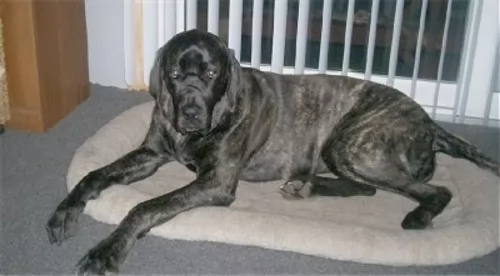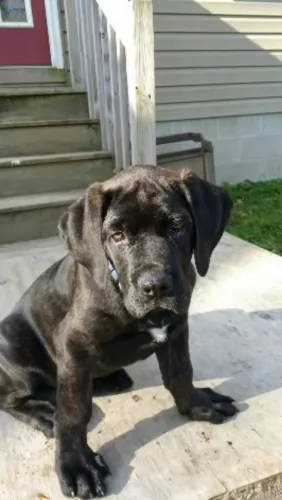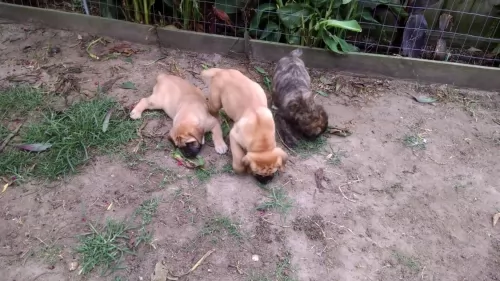 Petzlover
PetzloverDogo Cubano is originated from Cuba but Giant Maso Mastiff is originated from Germany. Dogo Cubano may grow 15 cm / 5 inches shorter than Giant Maso Mastiff. Dogo Cubano may weigh 44 kg / 97 pounds lesser than Giant Maso Mastiff. Both Dogo Cubano and Giant Maso Mastiff has almost same life span. Dogo Cubano may have less litter size than Giant Maso Mastiff. Both Dogo Cubano and Giant Maso Mastiff requires Low Maintenance.
The Cuban Mastiff which came from Cuba, was developed from breeds of Mastiffs, Bulldogs and cattle dogs, with the breed being thought to be extinct since the end of the 19th century.
The Dogo Cubano had a number of roles to fulfill in its day and they were used for guarding stock, for dog fighting and for chasing runaway slaves. After the abolishment of slavery, the large dog had no real role and it died out.
Known also as the Cuban Mastiff or Mastin de Cuba, there isn’t much accuracy as to its origins, with the most common story for their origin being that they are descendants of the Molossus.
The dogs were later introduced into Western Europe, becoming fairly common in England and Spain. The dog was also was also mentioned in the works of canine authors Stonehenge and George Wood.
 The Giant Maso Mastiff is a fairly new dog breed so you aren’t going to find much history on him.
The Giant Maso Mastiff is a fairly new dog breed so you aren’t going to find much history on him.
The breed was only started in 2001 so as to create a mastiff dog that would have fewer health problems and therefore have the chance to live longer. The Giant Maso came about because of a mix between the Old English Mastiff and the Cane Corso Italiano.
As stated, breeding began in 2001 and the dog has inherited intelligence and protective instincts from both these dogs.
The Dogo Cubano was generally similar to other Mastiffs and stood at rough 48 – 55cm in height and weighing in the region of 45kg.
He was a large dog, powerfully built, muscular and strong. Images of the dog show that it had strong, straight legs with a long tapering tail and medium-sized floppy ears that were sometimes cropped upwards and close to the head.
The dog breed came in a variety of colors such as brown, tan, fawn and brindle. The muzzle was broad and short and black. The dog had pronounced jowls with its face being fairly wrinkly.
This large dog was known for being a courageous, independent and aggressive dog. He became attached to his owner, showing protective characteristics .In those days the dog would have received simple training and certainly if such a large dog still existed today, it would have to receive training and socialization as well.
The Dogo Cubano was an intelligent dog and easily trainable, requiring an owner with a firm hand. Being an aggressive breed, the dog possibly wouldn’t have been the best companion for children. He also wouldn’t have got on too well with pets in the home as he was trained to be a fighter in his day. Independent and strong-willed, the dog would not have suited a novice dog owner.
 The Giant Maso Mastiff is a large dog breed and can stand at between 67 to 70cm in height and weigh 60 to 90-kg.
The Giant Maso Mastiff is a large dog breed and can stand at between 67 to 70cm in height and weigh 60 to 90-kg.
He has a big square head with medium sized floppy ears and thick neck covered with loose skin. Muscular, he is a deep chested dog with powerful legs and long tail. The fur of the dog is short and sleek and can be a number of colors such as fawn, an apricot color, gray and black as well as brindle.
Intelligent, protective, self-confident, balanced and calm, the Giant Maso Mastiff may be quite an imposing looking dog but he is gentle-natured towards his family.
The large dog loves to please and receive praise from his human family. He is the perfect friend, getting on well with children in the home as well as with other dogs. Training and socialization is easy for this dog and it is important that he is trained if you want him to be an obedient pet.
He is gentle, intelligent, protective – simply known as a gentle giant, being calm, steady and amicable. This breed loves to please and needs lots of companionship from his human family, loving just to lie close by to them.
He isn’t a particularly active dog, but will still need to join you on a walk every day. It is why the Maso Mastiff can live in the city or in the countryside, because not being an overly active dog, he doesn’t need a large garden.
The Dogo Cubano was bred to be a guard dog as well as for dog fighting, but this large dog, with training and socialization, no doubt became a loyal and devoted family pet.
It was actually a social dog, being aggressive towards other dogs. He would be described as a dog better suited to a home with older children.
He was protective with his human family but not very active, being too big to be leaping around like other dog breeds. It is a pity that this large dog has disappeared as he had some good qualities.
 Your Giant Maso Mastiff is such a gentle giant of a dog. He is well behaved and gentle so that it almost seems unnecessary to have him trained and socialized and yet doing so will make him even more amicable.
Your Giant Maso Mastiff is such a gentle giant of a dog. He is well behaved and gentle so that it almost seems unnecessary to have him trained and socialized and yet doing so will make him even more amicable.
Calm and gentle he makes the perfect pet for families where there are children as well as elderly people. He is quite frankly everyone’s friend, being a loving family pet. If you’re a family more into indoor games and TV watching than an outdoor, sporty kind of family, the Giant Maso Mastiff will suit you.
He will love to settle down and watch TV with you. He isn’t particularly active, although he will certainly need a walk every day.
Those who have owned a Giant Maso Mastiff will tell you that this is an excellent family pet, making a wonderful companion dog.
The Dogo Cubano was a generally healthy breed, but just like with most other dog breeds, they were also prone to some of the more common dog problems. The chances of him getting sick were slim though.
When the dog first originated, there were unlikely to have been health clearance certificates, but today, you’d want health clearances from the Orthopedic Foundation for Animals.
The reason for this is that hip dysplasia is a heritable condition, seen more often in large dogs, where the thigh bone doesn’t fit into the hip joint properly. The dog suffers with pain and discomfort and the condition can lead to lameness with the dog.
Gastric Torsion or Bloat is a life threatening condition that affects large dogs like the Dogo Cubano and those with deep chests. The stomach is distended with gas and it can twist.
The gas can’t escape and blood flow is hindered. The dog vomits, is lethargic and weak, and immediate veterinary help will be required.
 There has always been the concern with joint disorders in large breed dogs. Both hip- and elbow dysplasia can occur with your Giant Maso Mastiff, more so if you overfeed him as a puppy and he grows too fast.
There has always been the concern with joint disorders in large breed dogs. Both hip- and elbow dysplasia can occur with your Giant Maso Mastiff, more so if you overfeed him as a puppy and he grows too fast.
With hip dysplasia, the long bone of the leg forms incorrectly. This can lead to pain and lameness with your pet.
Also check out bloat. This is a serious illness when the stomach fills with air and can twist. Gastric Dilatation-Volvolvus, is an emergency situation then which is found more often in large, deep-chested dog breeds.
If you see your dog with a bloated stomach and acting in a strange, lethargic way, get him to the vet immediately as bloat can be life threatening.
The Dogo Cubano was a large dog, so if he did become used to living in the city, he would have adapted better to life in the country.
He wasn’t a dog requiring too much exercise but he would have needed to go for walks. They were used as guard dogs long ago, and if he had been in existence today, you wouldn’t have been able to include him in your jogging and cycling as he was a dog that could easily overheat.
Not all dogs require the same amount of food. Long ago the Dogo Cubano wouldn’t have had the same variety of dog foods available today. Maybe the dog in those days was fed the same kind of food that his owner ate.
Today, if these dogs were still around, they would require the best quality ‘large dog breed’ kibble.
The better the dog food, the more nourishing it is and the healthier the dog is. The Dog Cubano would likely have been a dog that drooled, leaving quite a bit of backwash in the water bowl, so it would have been important to wash out the drinking bowl and to regularly replace it with cool, fresh water.
 As an average shedder, the smooth, shorthaired coat is easy to groom, and a good brush twice a week will be adequate.
As an average shedder, the smooth, shorthaired coat is easy to groom, and a good brush twice a week will be adequate.
The Giant Maso Mastiff has floppy ears and therefore these should be checked for ear infections. Wax build up and dirt will need to be checked and cleaned.
His nails will need to be clipped, especially if they don’t wear down on their own and his teeth will need to be cleaned 2 or 3x a week to avoid dental disease.
With a large dog breed puppy such as the Giant Maso Mastiff, rapid growth is a risk factor for developing joint and bone conditions. The growth period can last till 12 months and puppies of large breeds should actually have their caloric intake adjusted during this growth period.
It is important to ensure that your puppy grows at a slow, steady rate. If you are feeding dog food from the commercially manufactured range, if you aren’t sure, speak to your vet about large breed dog foods. You want to be sure that this gentle giant of yours receives the best dog food there is, whether commercial branded dog food or your own home-made food. Good nutrition is imperative for the health of your pet.